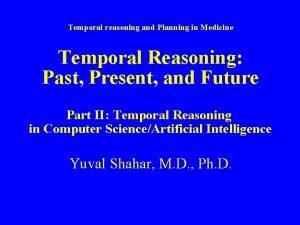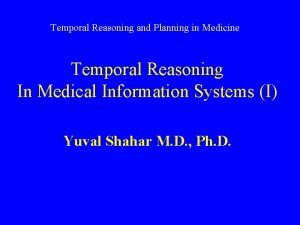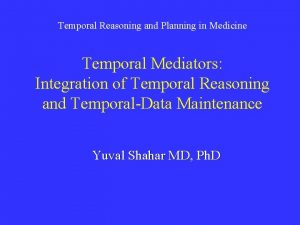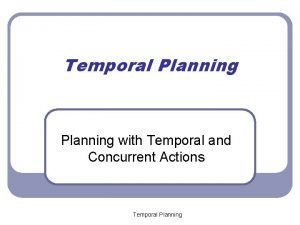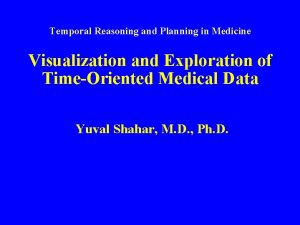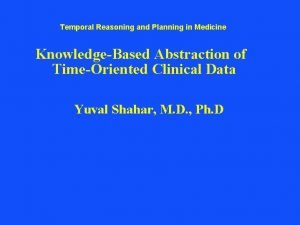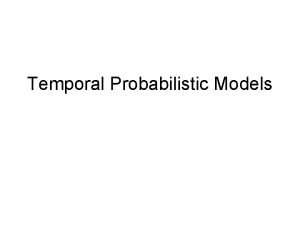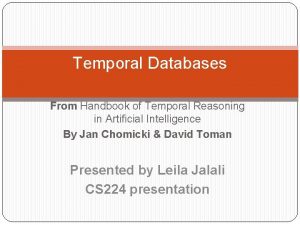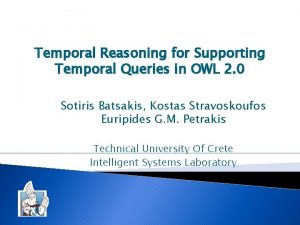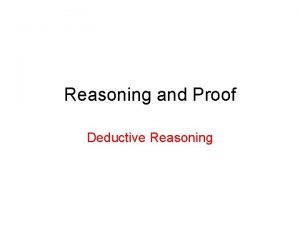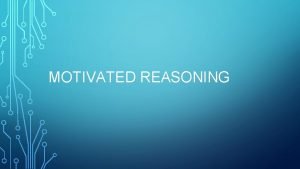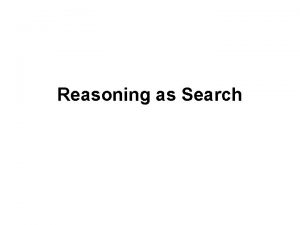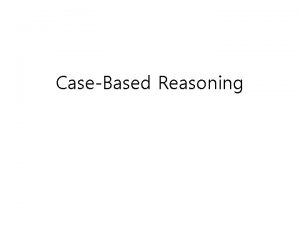Temporal reasoning and Planning in Medicine Temporal Reasoning















- Slides: 15

Temporal reasoning and Planning in Medicine Temporal Reasoning: Past, Present, and Future Part II: Temporal Reasoning in Computer Science/Artificial Intelligence Yuval Shahar, M. D. , Ph. D.

Kahn & Gorry's Time Specialist (Kahn & Gorry 1977) • Knowledgable about time — a domain-independent module • Isolates the temporal-reasoning element — not a temporal logic • Specializes in organizing temporal aspects of knowledge • Uses three different organization schemes, controlled by the user: - organizing by dates on a date line - organizing by special reference events (e. g. , birth, now) - organizing by before/after chains, for an event sequence • Maintains consistency of the data base • Answers questions of the type "what, " "when, " using a fetcher

The Time Specialist Architecture Memory Facts Corrections Facts Questions Fact Inference organizer methods Facts Error Doubted facts Consistency corrector checker Doubted facts New facts Questions User Questions

The Situation Calculus (Mc. Carthy 1957; Mc. Carthy and Hayes, 1969) • Represents actions and their effects on the world • The world is represented as a set of states • Actions are functions that map states to states: s True(s, closed_door) True(Result (open, s), Open_Door) • On(Block 1, Block 2) is not a predicate; On is a function that returns all states in which Block 1 is on Block 2; thus, True(s, Open_Door) means that s is a member of the set of states in which the door is open • Used for multiple tasks, especially planning • Major problems: – Concurrent actions cannot be represented – No duration of actions or delayed effects (Open creates result immediately) – Other problems that are not specific to the situation calculus

Hayes’ Histories (1985) • A history is an entity that incorporates time and space • An object O in a situation s, represented as O@S, is the intersection of the situation with the object’s history • Permanent locations are bound spatially, but are restricted temporally • Situations are unbound spatially, but are limited temporally by surrounding events • Most objects are between these two extremes • Events are instantaneous • Episodes have a duration => The history of an object can be described over time

Qualitative Physics • Introduced by Hayes in his Naïve Physics Manifesto (1978, 1985), in which he argued formalizing and axiomatizing a sizable portion of the real world (also known as commonsense reasoning) • Taken up by the Qualitative Physics (QP) branch of the Artificial Intelligence research community – Circuits were described as components and connections (De Kleer and Brown, 1985) – Qualitative Process Theory reasoned about active processes such as boiling water (Forbus 1984) – A general qualitative simulation framework (QSIM) was developed and implemented in software (Kuipers, 1986) – A methodology was developed to describe and detect cycles in repeating processes (Weld, 1986)

Time in Qualitative Physics • QP approaches usually have no explicit representation of time – Instead, they refer to a set of key states (landmarks) and a transition function that changes a state into another state • Typically, even when time is modeled, it is used only implicitly – Time is often an independent variable in qualitative equations, rather than a first-class citizen with its own properties

Kowalsky & Sergot's Event Calculus (1986) • Developed for updating databases and for narrative understanding • Based on the notion of an event and its descriptions (relationships) • Relationships are ultimately over time points after(e) = the period of time started by event e • Udates can only add; deletions add new information about the end of the period of time over which the old relationship holds • Uses nonmonotonic, default reasoning since relations change as new information arrives (a new event can signal the end of an old one) • Allows partial description of events, using semantic cases • Defined and interpreted as Horn clauses in Prolog: Assigned-to(Person, Project, after(Event)) IF employed-on (Person, Project, Event)

Allen's Temporal Logic (1981– 84) • Intended to support natural-language understanding and planning • Time primitives are temporal intervals - no instantaneous events • No branching into the future or the past • 13 basic (binary) interval relations [b, a, eq, o, oi, s, si, f, fi, d, di, m, mi], such as Before and After; six are inverses of the other six • Supported by a transitivity table that defined the conjunction of any two relations and a sound but incomplete algorithm that propagates efficiently (in O(n 3)) the results of applying the relations • All 13 relations can be expressed using meet [Allen & Hayes 85]; Before (X, Y) Z , (meets(X, Z) (meets (Z, Y)) X Z Y

Allen’s 13 Temporal Relations A A is EQUAL to B B B is EQUAL to A A A is BEFORE B B A B is AFTER A A MEETS B B B is MET by A A OVERLAPS B A B is OVERLAPPED by A A STARTS B B A B B is STARTED by A A FINISHES B B is FINISHED by A A DURING B B CONTAINS A

Allen’s Temporal Ontology • Properties hold over every subinterval of an interval —> Holds(p, T) e. g. , "Patient 1's skin was blue throughout sunday" • Events hold only over an interval and not over any subinterval of it [note that they are not identified with a set of intervals] —> Occurs(e, T) e. g. , "patient 2 broke a leg at 5 pm" • Processes hold over some subintervals of the interval they occur in —> Occuring(p, T) e. g. , "patient 3 is chasing the nurse"

Mc. Dermott's Temporal Logic (1982) • Goals: to model causality, continuous change and planning • Time primitives are points • Time is continuous — the time line is the set of real numbers • States Si are instantaneous shots of the world with an order-preserving date function that maps them into time points • A fact such as (On A B) is the set of states where A is on B, and are represented as (T s p) (the proposition p is true in state s; or: s is a member of the set of states in which p is true) • An event e is the set of intervals (pairs of states) during which it happens, and is represented as (Occur S 1 S 2 e)

Mc. Dermott’s Chronicles • States are partially ordered and branching into the • future, but totally ordered in the past (known past, • indeterminate future) • • Each maximal linear path in the state tree is a • chronicle • A chronicle is a complete history of the world, a totally • ordered set of states, extending to the indefinite past • and future

Shoham's Temporal Logic (1987) • Time primitives are points • Propositions are interpreted over intervals • Reified first-order logic: TRUE(t 1, t 2, color(house 17, red)), - rejects the simple FOL approach: color( t 1, t 2, house 17, red) which does not grant time any special status - rejects the modal approach: M, t 1, t 2, color(house 17, red) which can be subsumed by reified FOL • Provides clear semantics to a temporal formalism, without any of the particular commitments made by Allen or Mc. Dermott (such as by distinguishing facts from events)

Shoham’s Temporal-Proposition Types • Relate the truth of the proposition over one time interval to the truth of the proposition over other time intervals – Downward-hereditary: Whenever it holds over an inteval it holds over all its subintervals (John was in a coma on Tuesday) – Upward-hereditary: Whenever it holds for all proper subintervals of an interval, it holds over the interval (John received an infusion of insulin at the rate of 2 units per minute) – Gestalt: Whenever it holds over an interval, it never holds over a subinterval of that interval (John was in a coma for 2 weeks) – Concatenable: Whenever it holds over two consecutive intervals, it holds over their union (John had high blood pressure) – Solid: Whenever it holds over an interval, it never holds over an overlapping interval (e. g. , John received a full course of chemotherapy from start to end) => Allen's properties are downward-hereditary propositions; Allen's and Mc. Dermott's events are gestalt, solid or both.
 Deductive method
Deductive method Example of reasoning
Example of reasoning V
V Inductive argument
Inductive argument Inductive and deductive reasoning geometry examples
Inductive and deductive reasoning geometry examples Every quiz has been easy. therefore the quiz will be easy
Every quiz has been easy. therefore the quiz will be easy Inductive reasoning is reasoning based on patterns
Inductive reasoning is reasoning based on patterns N planning
N planning Long medium and short term planning in primary schools
Long medium and short term planning in primary schools Language policy and planning slideshare
Language policy and planning slideshare Strategic planning vs tactical planning
Strategic planning vs tactical planning Goal achievement matrix
Goal achievement matrix Role segmentation workforce planning
Role segmentation workforce planning Aggregate planning is capacity planning for
Aggregate planning is capacity planning for Aggregate planning is capacity planning for
Aggregate planning is capacity planning for Aggregate planning is capacity planning for
Aggregate planning is capacity planning for
















